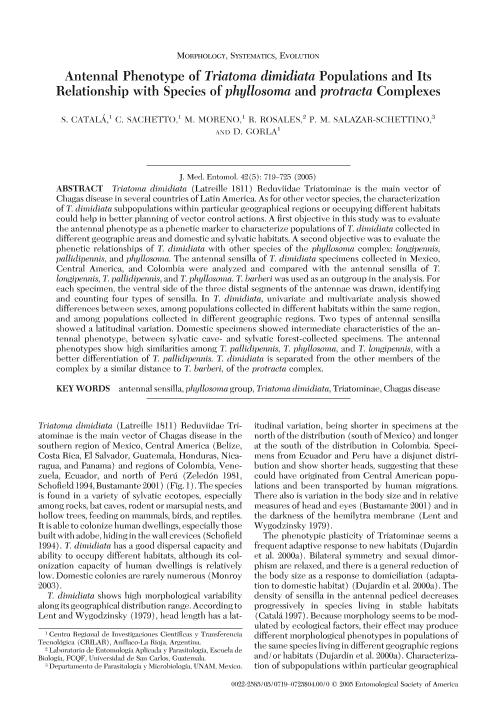Artículo
Antennal Phenotype of Triatoma dimidiata Populations and Its Relationship with Species of phyllosoma and protracta Complexes
Catala, Silvia Susana ; Sachetto, C.; Moreno, Mariana Laura
; Sachetto, C.; Moreno, Mariana Laura ; Rosales, R.; Salazar Schettino, P. M.; Gorla, David Eladio
; Rosales, R.; Salazar Schettino, P. M.; Gorla, David Eladio
 ; Sachetto, C.; Moreno, Mariana Laura
; Sachetto, C.; Moreno, Mariana Laura ; Rosales, R.; Salazar Schettino, P. M.; Gorla, David Eladio
; Rosales, R.; Salazar Schettino, P. M.; Gorla, David Eladio
Fecha de publicación:
09/2005
Editorial:
Entomological Society of America
Revista:
Journal of Medical Entomology
ISSN:
0022-2585
Idioma:
Inglés
Tipo de recurso:
Artículo publicado
Clasificación temática:
Resumen
Triatoma dimidiata (Latreille 1811) Reduviidae Triatominae is the main vector of Chagas disease in several countries of Latin America. As for other vector species, the characterization of T. dimidiata subpopulations within particular geographical regions or occupying different habitats could help in better planning of vector control actions. A Þrst objective in this study was to evaluate the antennal phenotype as a phenetic marker to characterize populations of T. dimidiata collected in different geographic areas and domestic and sylvatic habitats. A second objective was to evaluate the phenetic relationships of T. dimidiata with other species of the phyllosoma complex: longipennis, pallidipennis, and phyllosoma. The antennal sensilla of T. dimidiata specimens collected in Mexico, Central America, and Colombia were analyzed and compared with the antennal sensilla of T. longipennis, T. pallidipennis, and T. phyllosoma. T. barberi was used as an outgroup in the analysis. For each specimen, the ventral side of the three distal segments of the antennae was drawn, identifying and counting four types of sensilla. In T. dimidiata, univariate and multivariate analysis showed differences between sexes, among populations collected in different habitats within the same region, and among populations collected in different geographic regions. Two types of antennal sensilla showed a latitudinal variation. Domestic specimens showed intermediate characteristics of the antennal phenotype, between sylvatic cave- and sylvatic forest-collected specimens. The antennal phenotypes show high similarities among T. pallidipennis, T. phyllosoma, and T. longipennis, with a better differentiation of T. pallidipennis. T. dimidiata is separated from the other members of the complex by a similar distance to T. barberi, of the protracta complex.
Palabras clave:
Antennal Sensilla
,
Pryllosoma Group
,
Triatoma Dimidiata
,
Triatominae
Archivos asociados
Licencia
Identificadores
Colecciones
Articulos(CRILAR)
Articulos de CENTRO REGIONAL DE INV. CIENTIFICAS Y TRANSFERENCIA TECNOLOGICA DE ANILLACO
Articulos de CENTRO REGIONAL DE INV. CIENTIFICAS Y TRANSFERENCIA TECNOLOGICA DE ANILLACO
Citación
Catala, Silvia Susana; Sachetto, C.; Moreno, Mariana Laura; Rosales, R.; Salazar Schettino, P. M.; et al.; Antennal Phenotype of Triatoma dimidiata Populations and Its Relationship with Species of phyllosoma and protracta Complexes; Entomological Society of America; Journal of Medical Entomology; 42; 5; 9-2005; 719-725
Compartir
Altmétricas



